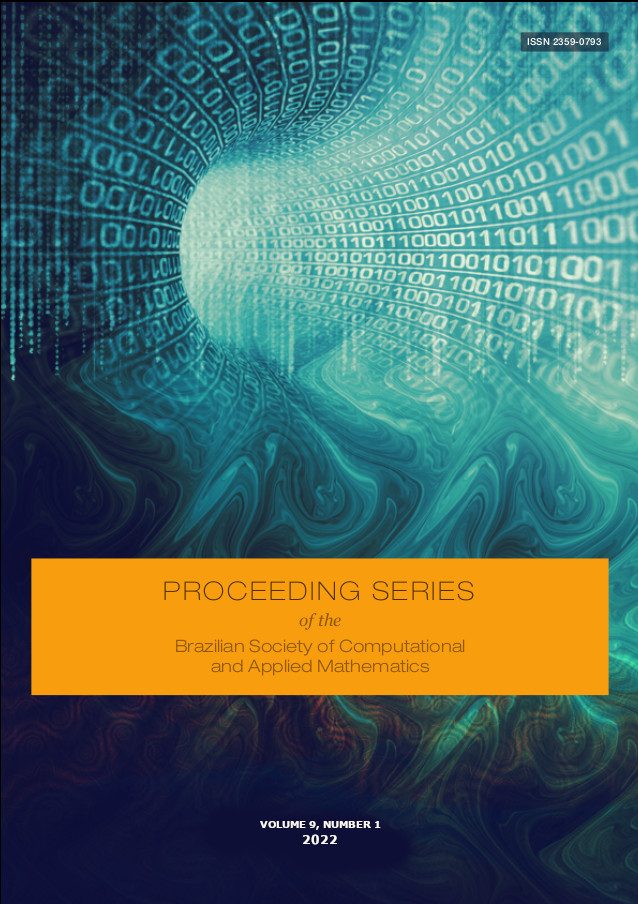Cellular Immune Dynamics Under The Cancer Inuence:Proposal of a Mathematical Model of Anti-Neoplastic Chemotherapy
DOI:
https://doi.org/10.5540/03.2022.009.01.0242Palavras-chave:
Cancer, Immunological Dynamics, Numerical Simulation, Doxorubicin.Resumo
Carcinogenesis is a formation process that causes modification in some genes through mutation of cells in the body. This process can be slow or happen quickly and aggressively, depending on individualizing peculiarities that can facilitate or inhibit tumor evolution. This pathology does not have specific causes and its study still generates many questions about the causative factors and the cellular interaction that allows such cellular proliferation of the disease. Based on this, this investigation seeks to understand the immune cell dynamics in the presence of tumor populations. To this end, we propose equations that aim to describe the behavior of specific cells and the production of cytokines, which are key elements acting in innate and adaptive immunity, contributing or hindering the spread of the pathogen in question. We also aim to understand and simulate the action of a specific drug, doxorubicin, applied in cycles, as an inhibitory agent in patients.
Downloads
Referências
I. M. Amima. Investigating tumour micro environment dynamics based on cytokine-mediated innate-adaptive immunity. Master dissertation. South Africa: Stellenbosch University, Faculty of Science, 2018.
T. M. Beer. Novel Blood-Based Early Cancer Detection: Diagnostics in Development. In: American Journal of Managed Care 26 (2020), S292 S299. doi: 10.37765/ajmc.2020. 88533.
N. Bellomo and L. Preziosi. Modelling and mathematical problems related to tumor evolution and its interaction with the immune system. In: Mathematical and Computer Modelling 32.3 (2000), pp. 413 452. issn: 0895-7177. doi: 10.1016/S0895-7177(00)00143-6.
N. Y. den Breems and R. Eftimie. The re-polarisation of M2 and M1 macrophages and its role on cancer outcomes. In: Journal of Theoretical Biology 390 (2016), pp. 23 39. issn: 0022-5193. doi: 10.1016/j.jtbi.2015.10.034. 7
V. Cristini, E. Koay, and Z. Wang. An Introduction to Physical Oncology: How Mechanistic Mathematical Modeling Can Improve Cancer Therapy Outcomes. 1th. Chapman & Hall/CRC Mathematical Biology Series, 2017. isbn: 978-1466551343.
C. A. Dinarello. Historical Review of Cytokines. In: European Journal of Immunology 37 (2007), S34S45. doi: 10.1002/eji.200737772.
R. Eftimie and H. Hamam. Modelling and investigation of the CD4+ T cells Macrophages paradox in melanoma immunotherapies. In: Journal of Theoretical Biology 420 (2017), pp. 82 104. issn: 0022-5193. doi: 10.1016/j.jtbi.2017.02.022.
S. N. Gardner. A mechanistic, predictive model of dose-response curves for cell cycle and phase-specic and -nonspecic drugs. In: Cancer Research 60 (2000), 14171425.
S. Gupta et al. International trends in the incidence of cancer among adolescents and young adults. In: JNCI: Journal of the National Cancer Institute (Feb. 2020). issn: 0027- 8874. doi: 10.1093/jnci/djaa007.
E. Kim. Dissecting resistance mechanisms in melanoma combination therapy. Online. Acessado em 22/03/2022, https://www.biorxiv.org/content/10.1101/041855v2. full.pdf.
T. J. Kindt, R. A. Goldsby, and B. A. Osborne. Kuby Immunology. 6th. W. H. Freeman, 2007. isbn: 9781429202114.
V. A. Kuznetsov et al. Nonlinear dynamics of immunogenic tumors: Parameter estimation and global bifurcation analysis. In: Bulletin of Mathematical Biology 56.2 (1994), pp. 295 321. issn: 0092-8240. doi: 10.1016/S0092-8240(05)80260-5.
K. J. Mahasa et al. Mathematical model of tumorimmune surveillance. In: Journal of Theoretical Biology 404 (2016), pp. 312 330. issn: 0022-5193. doi: 10.1016/j.jtbi. 2016.06.012.
M. T. McKenna et al. A Predictive Mathematical Modeling Approach for the Study of Doxorubicin Treatment in Triple Negative Breast Cancer. In: Scientic Reports 7.5725 (2017), pp. 114. doi: 10.1038/s41598-017-05902-z.
S. O'Hanlon, A. O'Donovan, and A. Cree. Geriatric oncology: assessing the needs of older people with cancer. In: British Journal of Hospital Medicine 80.5 (2019), pp. 252257. doi: 10.37765/ajmc.2020.88533.
L. G. de Pillis et al. Mathematical model creation for cancer chemo-immunotherapy. In: Computational and Mathematical Methods in Medicine 10.3 (2009), pp. 165 184. doi: 10.1080/17486700802216301.
L. Reips, L. A. S. França, and R. Aleixo. Modelagem matemática aplicada à dinâmica de células imunológicas mediante a presença de populações tumorais. In: Proceeding Series of the Brazilian Society of Computational and Applied Mathematics. Vol. 8. 1. 2021, pp. 17. doi: 10.5540/03.2021.008.01.0436.
RxList Inc. Adria (doxorubicin hydrochloride) drug indications and dosage. January 2007. Acessado em 22/03/2022, http://www.rxlist.com/cgi/generic/adriamycin _ids.htm.
L.M. Sompayrac. How the Immune System Works. 5th. Wiley-Blackwell, 2015. isbn: 9781118997819.
A. Yates et al. Cytokine-modulated regulation of helper T cell populations. In: Journal of Theoretical Biology 206 (2000), pp. 539560. doi: 10.1006/jtbi.2000.2147

